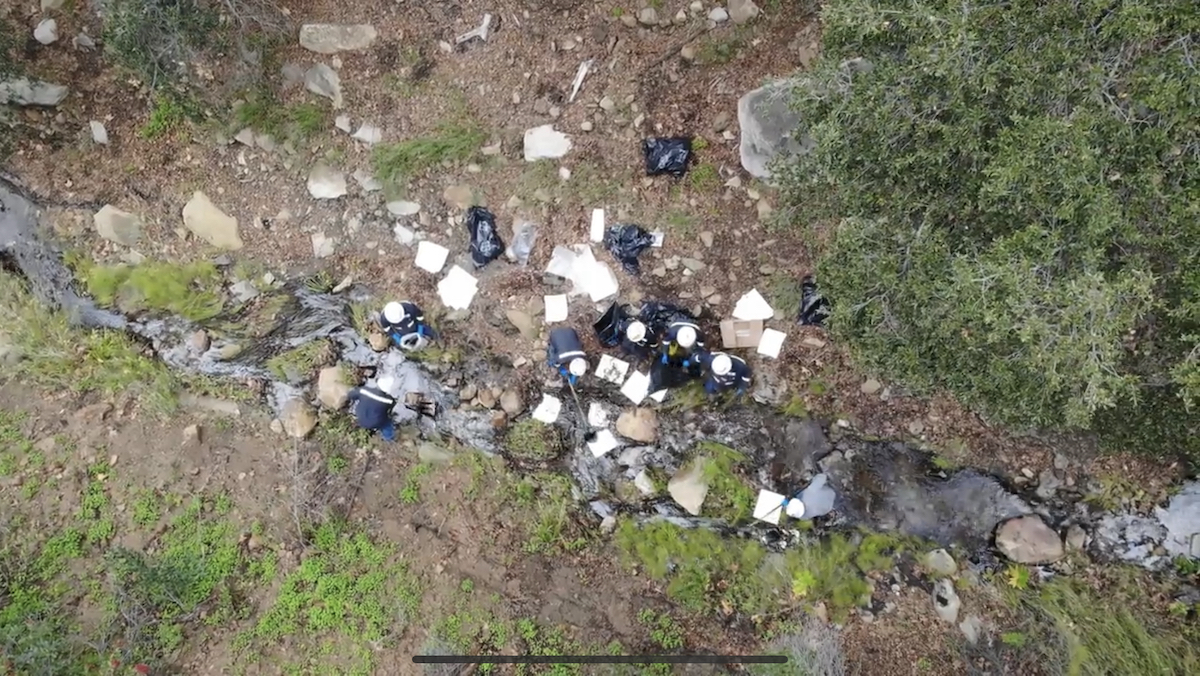There Will Be (Bad) Blood over Toro Creek Oil Spill
Santa Barbara County DA Takes County Counsel to Court in Showdown over Leaking 19th-Century Oil Well

First responders in Santa Barbara County celebrated New Year’s Day by working to contain an oil spill oozing from an abandoned open-pit oil-mining operation dating back to the 19th century up Toro Creek high in the foothills overlooking Montecito and Summerland. This year’s drenching winter rains appear to have overwhelmed the carrying capacity of an improvised pipeline and catch-basin created 25 years ago to keep the oil from dribbling out of that unpluggable pit — at a rate of 30 gallons a day — and creeping into the nearby creek and washing downstream with the rushing rains.
As of this writing, it remains uncertain just how much oil got into the creek. But reportedly none has been observed south of Highway 192 along Toro Canyon Road.
By Sunday afternoon, teams of first responders — representing firefighters from multiple fire agencies, county Public Works employees, and workers with the California Department of Fish and Wildlife were busy digging dams, laying booms to block the flow of oil-soaked water, and laying down reams of oil-absorbent material.

By Tuesday, 50-60 workers would find themselves deployed in the effort. They included a team of specialists dispatched from UC Davis’s veterinary school sent to determine how many fish, birds, frogs, and reptiles may have perished. To date, it’s not clear if any have.
Pacific Petroleum, a company specializing in oil-spill cleanup, also sent along a vacuum truck with two operators to be on site 24/7 for the duration. Given the intensity of the downpour anticipated this week, that duration could prove to be intense and problematic in the extreme.
This marks the latest of many petrochemical aftershocks emanating from an oil mine drilled a couple of hundred feet into Toro Canyon’s steep hillsides back in the 1880s. As such, it’s been part of an especially complicated environmental shaggy-dog story with much shifting responsibility as to which government agency is on the hot seat for plugging the leak and cleaning up the mess.
The last spill of significance occurred in August 2020, when more than 600 gallons got loose, killing at least 17 birds, 13 bats, and one squirrel. By that time, the County of Santa Barbara had sole responsibility for containing the leak.
In 1997, 3,000 gallons leaked into the creek when a vandal destroyed a prior makeshift effort to separate the oil from the water. At that point, the Environmental Protection Agency asserted its control but subsequently passed it off.
Five years before that, there had been another spill.
In a word, it’s been a mess.
Now it’s just gotten messier still. In the last week of 2022, the Santa Barbara District Attorney’s Office filed legal papers accusing the County Counsel’s office of stonewalling its efforts to investigate the county’s response to the 2020 spill. Specifically, prosecuting attorneys Morgan Lucas and Christopher Dalbey charged the County Counsel’s office with violating the state’s Public Records Act in connection with documents pertaining to the 2020 oil spill that the DA requested and that County Counsel has declined to turn over.
If this isn’t unprecedented in county history, it might as well be.
Sign up for Indy Today to receive fresh news from Independent.com, in your inbox, every morning.
The DA’s Environmental Protection Unit has been investigating the response to that August 2020 spill by the county’s Public Works Department since it first learned of the spill in July 2021. In September that year, the DA’s Office met with the County Counsel’s office — which represents the county in legal matters — and submitted a laundry list of documents it needed to determine whether the county’s response was legally adequate and whether criminal or civil charges should be filed in response.
In their pleading, prosecuting attorneys Lucas and Dalbey noted the county was first notified of the prior spill in August 2020. By January 2021, they stated, that leak had reached the creek. But the County waited until July 6, 2021, they concluded, before starting work on repairs.
“The leak continued for nearly a year with very little effort from the County to contain it or to stop it from flowing into Toro Canyon Creek,” they wrote.
Lucas and Dalbey described at length the efforts they say they went through to get the documentation they sought and the delays they encountered. They wanted to know such things as which employees were charged with maintaining the Oil and Water Separation Unit installed by the EPA and what level of training they’d been given had. They wanted to know — among many other things — whether the Underground Storage Unit was properly permitted and what steps were undertaken to ensure it didn’t leak.

They claimed representatives from the County Counsel’s office initially pledged to provide them all the information they sought and then engaged in repeated delays. Ultimately, many documents were, in fact, turned over, but not nearly as many as they asked for.
Only last November were they officially notified, they said, that they wouldn’t be getting all of it.
Private attorneys hired by the county to provide criminal representation argued that the Public Record Act was an inappropriate vehicle for seeking such information. If the DA wishes to pursue criminal action, attorney Davina Pujari wrote, on December 5, 2022, it should go to a judge with probable cause and get a search warrant.
“The County does not consent to a law enforcement search of its employees’ offices and computers for criminal investigatory purposes,” Pujari wrote.
Citing multiple other exemptions to the Public Records Act, Pujari argued that disclosure of internal communications among key administrators could discourage the candor needed for the job, especially during times of crisis and duress.
Pujari argued that no sanctions — whether civil or criminal — were warranted. The county assumed control of the site in 2009 when the EPA bowed out. The Regional Water Quality Control Board had helped fund the oil and water separation facility until 2019. That’s roughly two years after the Thomas Fire and the subsequent debris flow effectively destroyed the separator infrastructure. At that point, the county found itself forced to assume both oversight and financial responsibility for the site.
To date, the county has committed to spending $1.5 million on replacing the damaged separator and underground storage tank. To date, it’s also spent more than $200,000 on legal fees and costs associated with providing the information requested by the DA’s office while simultaneously fighting those requests.
Support the Santa Barbara Independent through a long-term or a single contribution.




You must be logged in to post a comment.